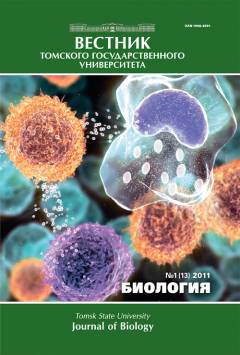On some seasonal aspects of spiders and harvestmen population (Arachnida: Aranei, Opiliones) in larch forests of the Tigirekski Reserve (North-Western Altai)
The aim of our study was to investigate the composition and structure of spiders and harvestmen population in larch forests of the Tigirekski Reserve.Seasonal changes in the spider and harvestmen communities of larch forests of the Tigirekski Reserve (the Altai, Russia) were studied for the first time: viz., the summer and autumn aspects in the postfire sparse larch-forest and the autumn aspect in the larchshrub forb-grass forest. We calculated and compared the main variation-statistical and quantitative characteristics of spider and harvestmen communities of the studied habitats. We showed that the summer community of the postfire larch-forest was represented by not less than 34 spider and two harvestmen species. The ground dwelling fauna consists of 20 species; of which 10 belong to five dominant families (Gnaphosidae, Hahnidae, Linyphiidae, Lycosidae and Thomisidae). A half of the spider community is represented by wolf-spiders. The majority of studied species are characterized by aggregated distribution. A dynamic density of harvestmen is much higher than that of spiders. The predominance of forest species (Zelotes fratris, Trochosa terricola and others) indicates that the spiders seem to have survived the ground fire rather than migrated from neighbouring (steppe) habitats. The autumn spider and harvestmen community of the postfire larch-forest is characterized by low density and poor taxonomic diversity. The litter-dwelling Linyphiidae were quite small in numbers. The absence of well-developed litter, which was destroyed by the ground fire 11 years ago and which would normally harbour litter dwellers during the winter, seems to be the main reason for the low density of linyphiids and other spiders. The super-dominant in this community was the diplochtonous wolf-spider Trochosa terricola. Harvestmen were represented by the single species (Oligolophus tridens), of which the dynamic density may decrease in dry years due to over-heating and drying of the burnt layer of plant residues. The autumn spider and harvestmen community of the larch-shrub forbgrass forest differs in a higher taxonomic diversity and dynamic density of both groups (the dynamic density of harvestmen was particularly higher). The webbuilder Allomengea scopigera predominated among spiders; its spatial distribution was the most even among all the recorded spider species. The coefficient of aggregation of another super-dominant (Agroeca proxima) was, on the contrary, the highest among all the spiders and harvestmen, close to 2. An absolute dominant of the harvestmen was Oligolophus tridens, amounting to 90%. Thus, our research has shown that the ground fire significantly changes the environment of ground- and soil-dwellers and affects the structure of the spider and harvestmen communities on the borderline between warm and cold seasons. A list of arachnids of the Tigireksky Reserve has been supplemented by eight species of spiders and one species of harvestmen. Acknowledgments: this work was supported by the Russian Federal Fundamental Scientific Research Programme for 2013-2020 (#VI.51.1.7.30.4). The arcticle contains 3 tables, 14 ref.
Keywords
Tigirekski Reserve, larch forests, synecologycal characteristics, spiders, harvestmen, Тигирекский заповедник, лиственничники, синэкологические характеристики, пауки, сенокосцыAuthors
| Name | Organization | |
| Trilikauskas Laimonas A. | Institute of Systematics and Ecology of Animals, Siberian Branch of the Russian Academy of Sciences | laimont@mail.ru |
References
_12_2014_1419234196.jpg)
On some seasonal aspects of spiders and harvestmen population (Arachnida: Aranei, Opiliones) in larch forests of the Tigirekski Reserve (North-Western Altai) | Vestnik Tomskogo gosudarstvennogo universiteta. Biologiya - Tomsk State University Journal of Biology. 2014. № 4 (28).
